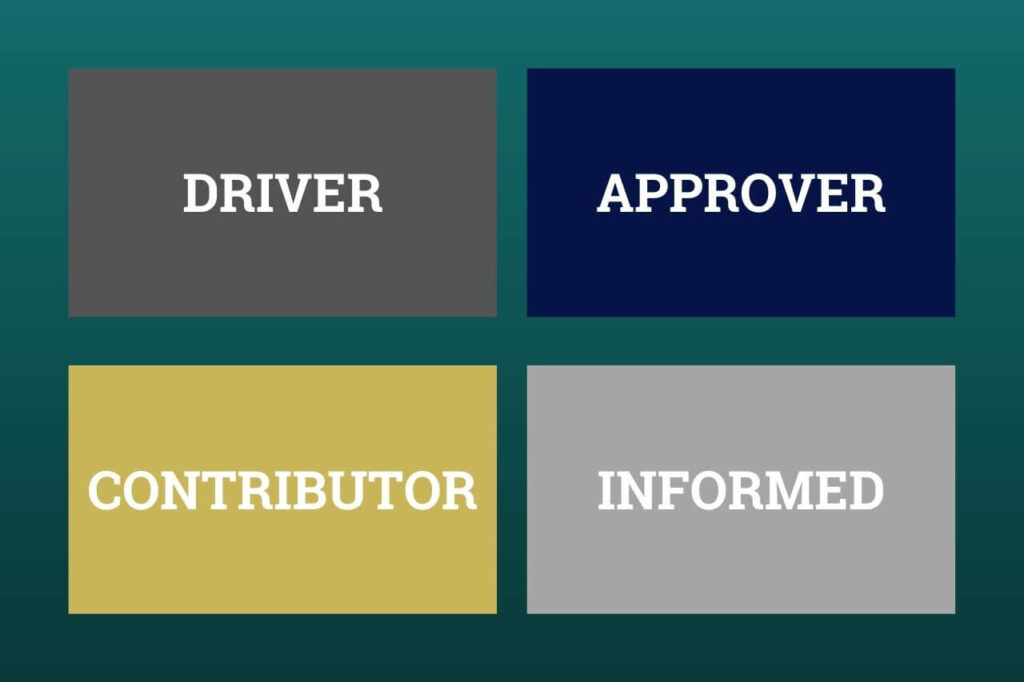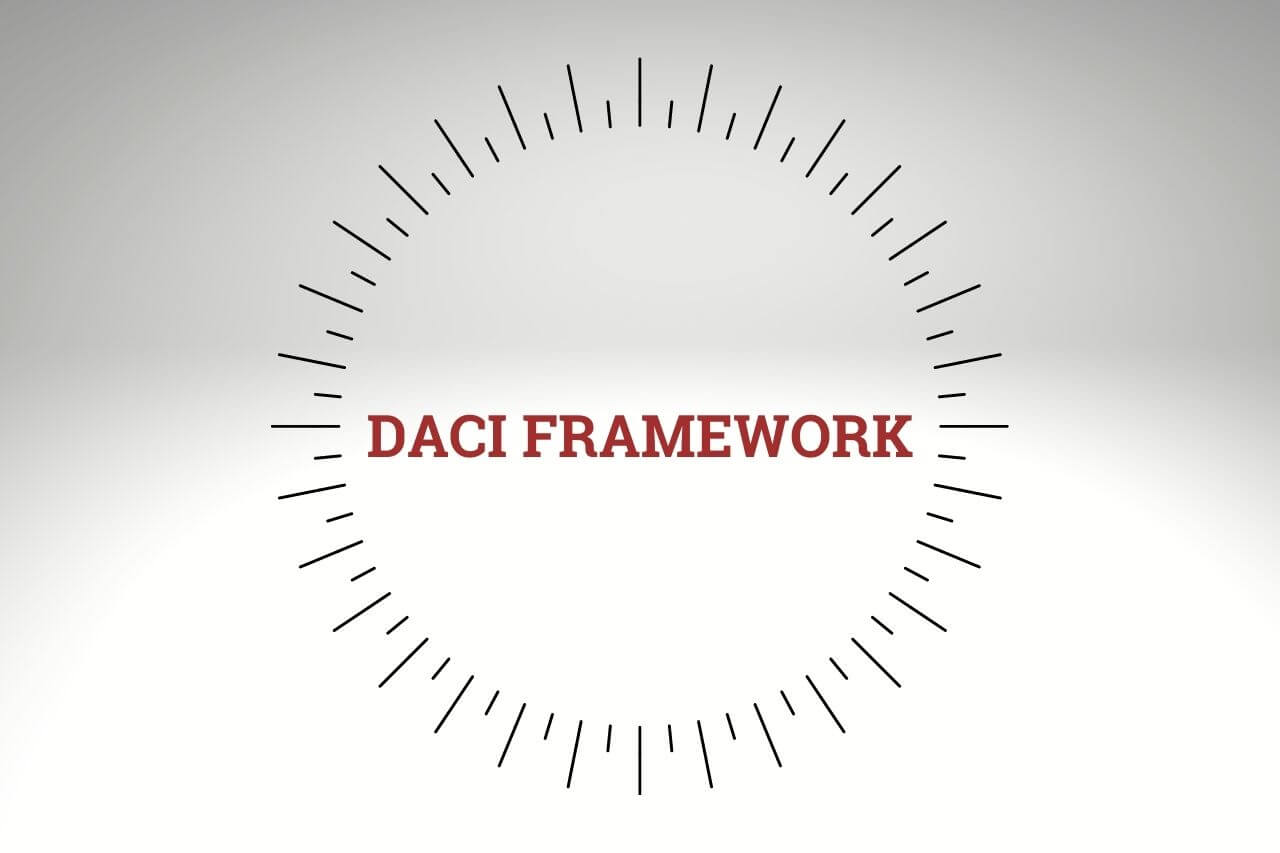For any project you manage, the decisions made by you, the team, and the project stakeholders are key to determining the success of the project and its role in meeting organizational goals.
If you’re tired of long, unproductive meetings and indecisive team members, then it’s time to revolutionize your team’s decision-making with DACI.
This powerful framework ensures that all necessary parties are involved in the process and that decisions are made in a transparent and accountable way.
With the DACI framework, you can say goodbye to wasted time and hello to efficient and effective decision-making and maximize efficiency in your projects.
In this guide, we’ll dive deep into the DACI framework and provide you with all the tools you need to start using it in your team.
What is DACI Framework?
DACI is a framework that can be used for decision-making in teams. It stands for Driver, Approver, Contributor, and Informed.
These are specialized roles for members of the team and using this framework eases the process of making decisions thus speeding up the project speed and reducing uncertainty.
In the DACI framework, the Driver is responsible for leading the decision-making process and ensuring that a decision is reached.
The Approver is the person who has the final say and makes the decision.
The Contributors are individuals who provide input and suggestions during the decision-making process.
The Informed are people who need to be kept informed about the decision but do not actively participate in the decision-making process.
Using the DACI framework can help ensure that all necessary parties are involved in the decision-making process and that the decision is made in a transparent and accountable way.

Read Also: 10 Top Benefits of Getting a PMP Certification
DACI Framework Roles
The roles of the DACI framework are Driver, Approver, Contributor, and Informed.
Driver
The Driver is a crucial role in the DACI framework for decision-making.
They’re responsible for leading the decision-making process and ensuring that a resolution is reached.
This includes identifying the issue or problem at hand, gathering relevant information, facilitating discussions and debates, and guiding the team towards a resolution.
The Driver should have a strong understanding of the issue and be able to effectively communicate and collaborate with team members.
It’s important for the Driver to be unbiased and objective and make sure that all necessary perspectives are considered during the decision-making process.
This role plays a key role in ensuring that the team’s decision-making process is efficient and effective.
Approver
The Approver is a key player in the DACI decision-making framework.
This person has the final say on the decision and is responsible for making the decision. I
t’s important for the Approver to have the necessary expertise and authority on the topic at hand, as well as consider all relevant information and perspectives before making a decision.
They should also be open to input from other team members and willing to listen to their suggestions and concerns.
It’s the Approver’s responsibility to communicate the decision to the rest of the team and any relevant stakeholders in a timely manner.
This role is crucial in ensuring that the team’s decisions are made in a transparent and accountable way.
Contributor
The Contributors are a vital part of the DACI framework for decision-making.
They provide input and suggestions during the decision-making process and play an important role in ensuring that all necessary perspectives are considered.
It’s important for Contributors to be open to input from other team members and to share their own ideas and insights.
They should also be willing to listen to and consider the suggestions of other team members.
While the Contributors are not responsible for making the final decision, their input is important in helping the team reach a well-informed and effective decision.
Informed
The Informed are individuals who need to be kept informed about the decision but do not actively participate in the decision-making process.
In the DACI framework, it’s important to make sure that the Informed are kept up to date on the status of the decision and any relevant developments.
This could include employees, clients, or other stakeholders who need to be aware of the decision but are not directly involved in the process.
The Informed should be notified of the final decision in a timely manner and given any necessary information or resources to understand its implications.
It’s important to make sure that the Informed are kept in the loop and that their needs are considered in the decision-making process.

Read Also: The Power Interest Grid and Stakeholder Management
Benefits of Using the DACI Framework
There are numerous benefits to using the DACI framework for decision-making in teams. Some of the main benefits include:
1. Improved Efficiency
By clearly identifying roles and responsibilities and streamlining the decision-making process, teams can make decisions more quickly and efficiently.
2. Better Quality of Decisions
By involving all necessary parties and considering all relevant perspectives, teams can make more informed and well-rounded decisions.
3. Increased Accountability
The DACI framework promotes transparency and accountability, as all parties are involved in the decision-making process and the final decision is made by the Approver.
4. Enhanced Collaboration
By fostering open communication and collaboration among team members, the DACI framework can help teams work together more effectively.
5. Greater Success
By making better and more informed decisions, teams can achieve greater success and productivity.

Read Also: 8 Great Ways To Inspire Your Agile Team For Top Productivity
How to Implement DACI in Your Team
Implementing the DACI framework in your team can be a simple and effective way to improve your decision-making process.
Here are some steps you can follow to get started:
1. Introduce the DACI framework to your team
Explain what DACI is and how it works. Make sure that everyone understands their role and the roles of the other team members.
2. Determine who will be the Driver for each decision
The Driver should be someone who has a strong understanding of the issue at hand, the ability to effectively communicate and collaborate with team members. and to lead the decision-making process.
This person will lead the decision-making process and ensure that a resolution is reached.
3. Identify the Approver
The Approver is the person who has the final say on the decision.
It is important to make sure that the Approver has the necessary expertise and authority to make the decision and consider all relevant information and perspectives before making a decision.
4. Identify the Contributors
The Contributors are individuals who will provide input and suggestions during the decision-making process.
It is important to make sure that all necessary perspectives are represented among the Contributors.
5. Identify the Informed
The Informed are people who need to be kept informed about the decision, but do not actively participate in the decision-making process.
Make sure to communicate the decision to the Informed in a timely manner.
By following these steps and consistently using the DACI framework, your team can make better and more informed decisions, leading to increased productivity and success.

DACI Matrix
A DACI matrix is a visual representation of the DACI framework for decision-making in teams.
It’s a useful tool for clearly identifying roles and responsibilities and ensuring that all necessary parties are involved in the decision-making process.
A DACI matrix typically includes a list of team members and their corresponding roles in the decision-making process (Driver, Approver, Contributor, Informed).
It can also include a description of the decision being made and any relevant deadlines or constraints.
Using a DACI matrix can help teams clearly define their roles and responsibilities and ensure that all necessary parties are involved in the decision-making process.
It can also help teams stay organized and on track, as it provides a visual representation of the decision-making process and helps teams track progress towards a resolution.

DACI Framework Examples
The DACI framework has been utilized by numerous teams to enhance their decision-making process and boost productivity.
Here are a few examples of how DACI has been effectively used in real-world scenarios:
Example 1
A large technology company used DACI to decide on a new project management tool.
The Driver led the decision-making process, the Approver made the final decision, and Contributors from various departments provided input.
The Informed were kept informed of the decision throughout the process.
By utilizing DACI, the company was able to efficiently choose a new tool that met the needs of all departments.
Example 2
A small marketing agency used DACI to decide on a new social media strategy.
The Driver led the decision-making process, the Approver made the final decision, and Contributors from the marketing and sales departments provided input.
The Informed included the rest of the agency’s employees and clients.
By using DACI, the agency was able to create a new strategy that aligned with the goals of both departments and effectively communicated to all stakeholders.
Example 3
A non-profit organization used DACI to decide on a new fundraising campaign.
The Driver led the decision-making process, the Approver made the final decision, and Contributors from the fundraising and marketing departments provided input.
The Informed included the rest of the organization’s employees and volunteers.
By using DACI, the organization was able to create a successful campaign that raised significantly more funds than previous efforts.
These are just a few examples of how the DACI framework can be utilized to improve decision-making in teams.
By involving all necessary parties and making decisions in a transparent and accountable way, teams can achieve greater success and productivity.

RACI vs DACI
Despite sounding alike, RACI and DACI are separate tools that are used in managing projects and teams.
While they are similar in many ways, there are a few key differences between the two frameworks.
A more sophisticated version of RACI, DACI addresses issues including managing cross-functional teams and group decision-making. RACI places more emphasis on who will be in charge of each individual assignment.
In addition, DACI designates who will be in charge of overseeing the project and who will approve final choices.
RACI stands for Responsible, Accountable, Consulted, and Informed. It is a tool for identifying roles and responsibilities in a decision-making process.
In the RACI framework, the Responsible person is responsible for completing tasks related to the decision, the Accountable person is ultimately responsible for the decision and its outcomes, the Consulted person is consulted for input during the decision-making process, and the Informed person is kept informed about the decision.
DACI stands for Driver, Approver, Contributor, and Informed.
It is similar to RACI in that it is a tool for identifying roles and responsibilities in a decision-making process.
In the DACI framework, the Driver leads the decision-making process, the Approver has the final say on the decision, the Contributors provide input and suggestions, and the Informed are kept informed about the decision.
One key difference between RACI and DACI is that the Approver in DACI has the final say on the decision, while the Accountable person in RACI is ultimately responsible for the decision and its outcomes.
Additionally, the DACI framework includes a specific role for leading the decision-making process (the Driver), while the RACI framework does not.
Overall, both RACI and DACI are useful tools for improving decision-making in teams, but the specific roles and responsibilities may vary depending on the framework being used.
Conclusion
By using DACI, teams can streamline their decision-making process and increase productivity. We encourage you to try using DACI in your own team and see the benefits for yourself.





